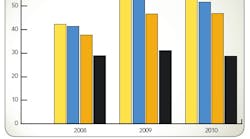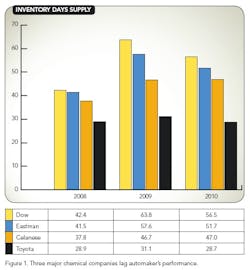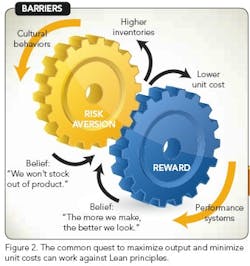Ask anyone in the chemical industry "What is Lean?" and you'll get a variety of responses. Lean's application in discrete manufacturing is well known; it even has won a role in non-manufacturing industries such as healthcare. However, most people in the chemical industry haven't seriously considered Lean's strategic advantages for the processes right around them. Many chemical companies dismiss Lean as a low-level improvement activity because they don't appreciate its power and value. We must make the case for Lean more clearly and broadly.
Convincing chemical companies to embrace Lean isn't enough. They must effectively deploy it. So here, we'll examine five critical factors for success:
1. Paying attention to the measures that matter in your organization.
2. Ditching behaviors that undermine optimization of the overall value stream.
3. Seeking comprehensive understanding of the needs and activities throughout the value stream.
4. Getting out of the mental rut and not limiting yourself by the way things always have been done.
5. Focusing on what you can do right now but never stopping to strive for perfection.
PAYING ATTENTION TO WHAT MATTERS
Many Lean initiatives start out on the wrong foot because they don't directly relate to measures important to the company.
Properly starting Lean begins with examining and understanding the company's (or business unit's) strategic aspirations and financial goals. I often hear Lean practitioners communicating their goals in terms of percent value-added. (I've done plenty of that myself.) The value-added metric isn't inherently bad — but chemical makers don't relate to it. The metric they understand and accept is money. That's a strong reason why Six Sigma has become the cornerstone of process improvement efforts inside chemical companies over the past 10 to 15 years.
You can express one conventional Lean metric, inventory days supply (IDS), in the form of money. IDS basically measures how long a company could serve customers if it stopped production immediately. Lean companies tend to carry less inventory — because they've built in the capability and controls to function effectively on less inventory and still serve customers' needs.
Let's compare the IDS of three chemical companies — Dow, Eastman and Celanese — to that of Toyota Motor, long considered the gold standard of Lean. Using information derived from each company's annual report, we can easily determine IDS via: IDS = (365 × Inventory)/Cost of Revenue. The three chemical companies in 2010 carried 18 to 28 more days of inventory on average than Toyota (Figure 1).
This matters because shortening the cash cycle (e.g., turning cash back into cash) can generate a significant financial windfall. To see the potential impact, let's examine a hypothetical situation. Suppose Eastman Chemical implements a Lean strategy that reduces its overall IDS by one day. In 2010, Eastman's annual cost of goods sold (COGS) was $4.368 billion; we'll assume 10% for cost of capital, which is a conservative number (some studies place the cost as high as 40–50% [1]). So:
• Average Daily COGS = $4,368,000,000/365 days = $12,000,000/day;
• IDS Improvement × Average Daily COGS = 1 day × $12,000,000/day = $12,000,000; and
• Earnings Impact = Average Days COGS × 10% Cost of Capital = $1,200,000.
This straightforward analysis doesn't take into account other potential benefits from relatively small changes in inventory — such as savings in transportation, warehousing and staffing. A well-executed Lean strategy often produces such side benefits.
Connect Lean with what really matters in your organization. Speak the language of business leaders by using metrics they can appreciate. This is the first step to becoming Lean.
DITCHING BAD BEHAVIORS
Some actions of individuals and organizations work against Lean (Figure 2). For example, consider performance appraisal systems. Tying rewards to throughput spurs individuals and organizations to seek to maximize their output. More output with the same (or less) inputs lowers the unit cost of manufactured chemicals because some charges like allocations are fixed. In addition, we get the added "bonus" of minimizing product stock-outs.
Let's pause here. Toyota has said the worst manufacturing sin is overproduction or making product before the needed time. For chemical makers that means running at 100% capacity utilization when not sold out. "Just in case" logic isn't a sustainable Lean strategy.
Before you argue your company wouldn't do that, ask anyone you work with: "What level of supply reliability should we have for our customers?" I'd wager the answer is 100% or 99.9%; maybe some daring soul would say 99%. Then ask: "What's the cost (relative to benefit) of trying to be that good given our current capabilities?" Or "How can we assure that level of reliability?" The most common response is "Add inventory." So, this brings us back to square one. We're in a vicious cycle created by our risk aversion and often-skewed performance systems.
This contrasts with the Lean concept of "Takt" — having our processes make what is consumed by the next process in the right quantity at the right time and at the right quality without generating any waste. In other words, production always should exactly match customer demand. Every manufacturer should strive for this ideal state.
Companies must cultivate the right behaviors and systems from the top down. This is the second step to becoming Lean.
SEEKING COMPREHENSIVE UNDERSTANDING
The chemical industry boasts plenty of people with good analytical and problem-solving skills. Take, for instance, Six Sigma black belts. They've done a good job of optimizing plants, units and processes. But even the most talented black belts and their managers usually have limited visibility of the value streams they seek to improve. Few people in an organization comprehend even at a high level all the activities along the value chain; many don't even remotely grasp what takes place beyond the physical boundaries of their company. Yet, understanding end-to-end value streams is essential. It's impossible to progress toward Lean without some level of sharing. This is a daunting but necessary task. As Jim Womack of the Lean Enterprise Institute says, "For every product or service there is a value stream, the challenge lies in seeing it."
The chemical industry is positioned in the middle of countless long, complex value streams. The constant squeeze between upstream suppliers (e.g., the Exxons of the world) and downstream customers (e.g., the Wal-Marts) creates numerous challenges. Some chemical producers respond by living with reduced profitability and flexibility. Others resort to cost-efficiency and cash-management moves to boost results. But we all know you can't save your way to prosperity. A better alternative is to create effective partnerships along your value streams.
We're not conditioned to talk to customers' customers or suppliers' suppliers. However, processors in the value stream working together in their mutual interest increase the probability of success for everyone. The automotive industry has many examples of this.
The versatility of our chemical technologies and products leads to very few "straight chains" between our companies and end users. So, it can be tough to identify in a meaningful way with the needs and activities of other processors along the value stream and, finally, the end consumer. But it's essential. We must go beyond merely conforming to product specifications (although that's necessary) and understand fitness for use.
Changing an organization's DNA is very difficult. You must get people to think broadly and seriously about value-stream needs and activities inside and outside your company's fences. This is the third step to becoming Lean.
GETTING OUT OF THE MENTAL RUT
Mapping is fundamental to understanding the needs and activities throughout the value stream. However, the insights gained won't generate results without a proper Lean framework. At this point, it's important to consider two pillars of a Lean system: flow and pull.
Let's begin with flow, a concept well known to chemical engineers. However, Lean flow is more than a system of unit operations. It requires thinking of the "work" performed by chemical processors through a different lens. Consider the following:
A manufacturer purchases and transports raw materials to its plant. It stores the materials (e.g., in warehouses, tanks or moving equipment) until they are ready for processing. Then the materials go (e.g., through piping or machines) to batch or continuous processing systems. Finally, products are sent to storage equipment or warehouses until they are ready for transport from the site to another facility.
This sequence applies to all manufacturing — details of specific value-stream activities differ depending upon industry. Ideally, the value flows smoothly toward the customer (order to delivery) without interruption in both physical and information processes. However, all manufacturing suffers flow interruptions due to various design, operational and maintenance factors.
Interrupted flow, regardless of the underlying cause, creates more dead time in the system and limits the potential (maximum) throughput of the end-to-end value stream. The dead time associated with raw materials and products usually dominates the total lead time of the end-to-end chemical value stream.
Dead time leads to more inventory. Typically, a chemical processor performs value-adding work only during a very small percent of the total lead time. Other industries commonly report 5–10% of the total lead time is value-adding. You might assume chemical processors do better because of their continuous unit operations. This often is a wrong assumption. Here's why:
Chemical plants are designed to run optimally (i.e., provide highest yield, etc.) at target production rates. Starting up, shutting down and slowing processes can often be costly. So, sites tend to run long campaigns and allow inventory levels to cycle up and down around planned (or unplanned) maintenance activities or product changeovers. Another Chemical Processing article [1] pointed out the benefits of shortening changeover activities and, in general, making them less painful. The advantages of this are clear: lower inventory and more capacity.
There's a lesson in this for chemical plant designers: consider right from the outset of work on any new plant or expansion the need to provide an inherent ability to manage chemical processes for optimum inventory control, proactive maintenance and frequent product changeovers. In other words, design in the ability to pull product through the value stream without overproduction and allow for cost-effective operation over a wide range of output rates. Much of the chemical industry today suffers a strategic disadvantage because it doesn't have these capabilities in a broad way.
Flow, while an incredibly important concept, alone doesn't create a Lean value stream. The ability to regulate flow in real time between unit operations and processors along the chain also is crucial. Lean practitioners usually describe this system of regulation as pull. Directing the customer production signal to one point in the value stream (sometimes called the pacemaker process) provides a number of advantages: simplified information flow and proper inventory control while reliably serving customers in a safe and environmentally sound manner.
Between continuous chemical operations, the application of pull usually is straightforward and handled by process control systems (e.g., level control devices that balance inventories between adjacent steps). Invariably, every value stream has some operations that can't or shouldn't be combined in a continuous flow — due to physical distances, adjacent processes with highly disparate cycle times or a variety of other factors. Tanks, warehouses and other types of storage systems often signal non-continuous processes within the chemical value stream. Pull systems vary in their specific form but all aim to regulate the production of each value-stream activity so that every step produces exactly what is required for the next downstream step at just the right time.
Designing and building toward versatile and flexible systems that perfectly flow value toward the customer without interruption, overproduction and added cost/pain is the pinnacle of operational excellence. This is the fourth step to becoming Lean.
FOCUSING ON WHAT YOU CAN DO NOW
Successful organizations constantly seek to improve and innovate. However, the need to fight today's fires can make that tough. It's essential to find the right balance between short-term performance commitments and continual improvement. Doing this well requires new behaviors and new styles of engagement for everyone from the production operator to senior management.
One way to succeed is through the kaizen (literally, continuous improvement) process. It's important to understand that just because something can be improved doesn't mean it should be improved (at least not immediately). Here are five practical ways to put the kaizen process to work:
1. Stay anchored to the priorities and insights made clear by value-stream mapping and analysis.
2. Use appropriate tools such as modeling and discrete event simulation [2] to accurately quantify the impact of potential changes on the value stream.
3. Once the best changes are known, implement them fast and be ready to accept an 80% solution for 20% of the effort.
4. Highlight results to gain support for the next kaizen and be willing to fine-tune the value stream over time.
5. Lastly, make sure that the solution sticks — leverage Six Sigma to develop an appropriate control plan.
Striving for perfection at what really matters, engaging the organization in the evergreen kaizen process and achieving quick wins that lead to visible impact on the value stream truly define what it means to be Lean. This is the fifth and final step to becoming Lean.
ADAM RUSSELL is a group leader and Six Sigma master black belt for Eastman Chemical Company, Kingsport, Tenn. Email him at [email protected].
References
1. Pratt, D., "A Marriage Made in Heaven" p. 25, Chemical Processing (May 2005).
2. Cope, D., "Consider Discrete Event Simulation," p. 27, Chemical Processing (Oct. 2010).




